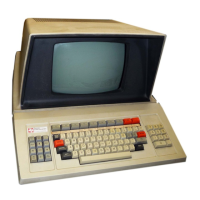~~--94_5_4_24_-9_7_0_1
____________________________________________
~
16 scan lines
per
row;
for
the
i
920-character
display,
there
are 10 scan lines
per
row.
Therefore,
each
character
is read 16
or
10 times
(once
each scan line)
for
display
on
the
screen.
The
ASCII
character
from
each location (even
those
not
displayed during
retrace)
is
presented
to
the
character
generator
each
character
time.
Then,
depending
on
the
line being
scanned,
a
pattern
is
produced
to
develop
the
video
for
that
particular
character.
The
first
character
of
the
row following
the
current
row
is
not
the
next
character
in
sequence
in
the
character
address
counter.
The
contents
of
the
character
address
counter
are
copied
into
the
character
address
latch
during
charncter
0
(for
the
row,
not
the
scan line).
The
vaiue in
the
character
address
latch
is
modified
during
the
scan
of
the
last line
of
every
row
at
character
time
90
(trailing edge
of
HSQ -
horizontal
sync). This places
the
value
in
the
latch
(05
16
in
the
case
of
the
first
row)
required
to
initialize
the
character
counter
at
the
end
of
the
scan line.
The
latch
contents
are
then
written
into
the
counter
as
050
16
as
the
first
character
(character
0)
of
the
second row.
Notice
that
during
the
scan
of
the
first row, characters
000
through
04F
16
are displayed,
and
characters
050
16
through
063
16
(normally
displayed in
second
row)
are accessed during horizon-
tal retrace. Characters
050
16
through
063
16
are
not
displayed
(at
this
time)
even
though
their
addresses are
presented
to
memory,
a
character
is read
from
memory,
and
an
output
(VDQ) is
produced
by
the
video
output
shift
register.
The
video
output
shift
register's
output
is
blanked
by
the
video
output
amplifier.
(If
the
VDT
controller
were
in
the
self-test
mode,
VDQ
would
stiil
be
returned
to
the
computer.)
Likewise,
if
the
cursor
is
at
some
location
(052
16
, for
example)
the
comparator
logic
indicates
a
cursor
compare
operation
while scanning
row
0,
but
the
compare
does
not
affect
the
blanked
screen.
NOTE
The
character
address
counter
values change in
such
a way
that
unique
character
values cannot
be
decoded
along a scan line (e.g.,
the
last
(99th)
character
of
row
0 is
063
16
;
of
row
1 is
OB3
16
:
of
row
2 is
103
16
, etc.).
The
least significant
four
bits
(KAD,3-0) are valid since
they
are set
to
0
at
the
beginning
of
each
scan line.
The
carry (KCOL)
from
this stage
of
the
character
address
counter
is used
to
enable
the
character
counter
to
develop KCH,0-2.
The
character
counter
is set
to
0
at
the
end
of
every scan line
(K99
L).
Character Decoder ROM. KAD(3-0)
and
KCH(2-0) are
decoded
by
the
character
decoder
ROM
as
shown
in
table
1-10
to
produce
the
following signals:
Standard (Row)
Character Signature
Description
0
KOOL
Character time 0
74 HDEQSL
End sync during vertical sync
79
HBSL
Start horizontal blanking
82
HDSL
Start horizontal drive
90
HDENDL
End horizontal drive
90
NHDENDL
Inverted end horizontal drive
99
K99L
Character time 99
99
NK99L
Inverted character time 99
---------------------------··'"--··---·-··---------
1-72
Digital
Systems Division

